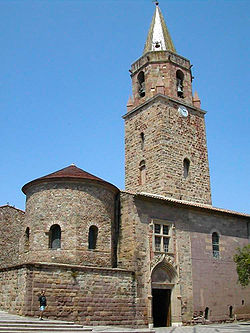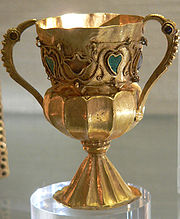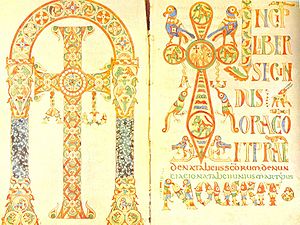
Merovingian art and architecture
Encyclopedia


Franks
The Franks were a confederation of Germanic tribes first attested in the third century AD as living north and east of the Lower Rhine River. From the third to fifth centuries some Franks raided Roman territory while other Franks joined the Roman troops in Gaul. Only the Salian Franks formed a...
, which lasted from the 5th century to the 8th century in present day France
France
The French Republic , The French Republic , The French Republic , (commonly known as France , is a unitary semi-presidential republic in Western Europe with several overseas territories and islands located on other continents and in the Indian, Pacific, and Atlantic oceans. Metropolitan France...
, Benelux
Benelux
The Benelux is an economic union in Western Europe comprising three neighbouring countries, Belgium, the Netherlands, and Luxembourg. These countries are located in northwestern Europe between France and Germany...
and a part of Germany
Germany
Germany , officially the Federal Republic of Germany , is a federal parliamentary republic in Europe. The country consists of 16 states while the capital and largest city is Berlin. Germany covers an area of 357,021 km2 and has a largely temperate seasonal climate...
.
The advent of the Merovingian dynasty in Gaul
Gaul
Gaul was a region of Western Europe during the Iron Age and Roman era, encompassing present day France, Luxembourg and Belgium, most of Switzerland, the western part of Northern Italy, as well as the parts of the Netherlands and Germany on the left bank of the Rhine. The Gauls were the speakers of...
in the 5th century led to important changes in the field of arts. Sculpture regressed to be little more than a simple technique for the ornamentation of sarcophagi
Sarcophagus
A sarcophagus is a funeral receptacle for a corpse, most commonly carved or cut from stone. The word "sarcophagus" comes from the Greek σαρξ sarx meaning "flesh", and φαγειν phagein meaning "to eat", hence sarkophagus means "flesh-eating"; from the phrase lithos sarkophagos...
, altars and ecclesiastical furniture. On the other hand, gold work
Goldsmith
A goldsmith is a metalworker who specializes in working with gold and other precious metals. Since ancient times the techniques of a goldsmith have evolved very little in order to produce items of jewelry of quality standards. In modern times actual goldsmiths are rare...
and the new medium of manuscript illumination
Illuminated manuscript
An illuminated manuscript is a manuscript in which the text is supplemented by the addition of decoration, such as decorated initials, borders and miniature illustrations...
integrated "barbarian" animal-style
Migration Period art
Migration Period art denotes the artwork of the Germanic peoples during the Migration period . It includes the Migration art of the Germanic tribes on the continent, as well the start of the Insular art or Hiberno-Saxon art of the Anglo-Saxon and Celtic fusion in the British Isles...
decoration, with Late Antique motifs, and other contributions from as far as Syria or Ireland to constitute Merovingian art.
Architecture
The unification of the FrankishFranks
The Franks were a confederation of Germanic tribes first attested in the third century AD as living north and east of the Lower Rhine River. From the third to fifth centuries some Franks raided Roman territory while other Franks joined the Roman troops in Gaul. Only the Salian Franks formed a...
kingdom under Clovis I
Clovis I
Clovis Leuthwig was the first King of the Franks to unite all the Frankish tribes under one ruler, changing the leadership from a group of royal chieftains, to rule by kings, ensuring that the kingship was held by his heirs. He was also the first Catholic King to rule over Gaul . He was the son...
(465 – 511) and his successors, corresponded with the need for the building of churches, and especially monastery churches, as these were now the power-houses of the Merovingian church. Plans often continued the Roman
Roman architecture
Ancient Roman architecture adopted certain aspects of Ancient Greek architecture, creating a new architectural style. The Romans were indebted to their Etruscan neighbors and forefathers who supplied them with a wealth of knowledge essential for future architectural solutions, such as hydraulics...
basilica
Basilica
The Latin word basilica , was originally used to describe a Roman public building, usually located in the forum of a Roman town. Public basilicas began to appear in Hellenistic cities in the 2nd century BC.The term was also applied to buildings used for religious purposes...
tradition, but also took influences from as far away as Syria and Armenia. In the East, most structures were in timber, but stone was more common for significant buildings in the West and in the southern areas that later fell under Merovingian rule. Most major churches have been rebuilt, usually more than once, but many Merovingian plans have been reconstructed from archaeology. The description in Bishop
Bishop
A bishop is an ordained or consecrated member of the Christian clergy who is generally entrusted with a position of authority and oversight. Within the Catholic Church, Eastern Orthodox, Oriental Orthodox Churches, in the Assyrian Church of the East, in the Independent Catholic Churches, and in the...
Gregory of Tours
Gregory of Tours
Saint Gregory of Tours was a Gallo-Roman historian and Bishop of Tours, which made him a leading prelate of Gaul. He was born Georgius Florentius, later adding the name Gregorius in honour of his maternal great-grandfather...
' History of the Franks of the basilica of Saint-Martin, built at Tours by Saint Perpetuus
Saint Perpetuus
Saint Perpetuus was the sixth Bishop of Tours, from 460 to 490. He succeeded his relative, probably an uncle, Eustochius, and was succeeded by another close relative, Saint Volusianus....
(bishop 460-490) at the beginning of the period and at the time on the edge of Frankish territory, gives cause to regret the disappearance of this building, one of the most beautiful Merovingian churches, which he says had 120 marble columns, towers at the East end, and several mosaics: "Saint-Martin displayed the vertical emphasis, and the combination of block-units forming a complex internal space and the correspondingly rich external silhouette, which were to be the hallmarks of the Romanesque". A feature of the basilica of Saint-Martin that became a hallmark of Frankish church architecture was the sarcophagus or reliquary of the saint raised to be visible and sited axially behind the altar, sometimes in the apse
Apse
In architecture, the apse is a semicircular recess covered with a hemispherical vault or semi-dome...
. There are no Roman precedents for this Frankish innovation. The merovingian church of Saint-Pierre in Vienne
Vienne, Isère
Vienne is a commune in south-eastern France, located south of Lyon, on the Rhône River. It is the second largest city after Grenoble in the Isère department, of which it is a subprefecture. The city's population was of 29,400 as of the 2001 census....
is the only surviving one. A number of other buildings, now lost, including the Merovingian foundations of Saint-Denis
Saint-Denis
Saint-Denis is a commune in the northern suburbs of Paris, France. It is located from the centre of Paris. Saint-Denis is a sous-préfecture of the Seine-Saint-Denis département, being the seat of the Arrondissement of Saint-Denis....
, St. Gereon
St. Gereon's Basilica
St. Gereon's Basilica is a Roman Catholic church in Cologne, Germany, dedicated to Saint Gereon, and designated a minor basilica on June 25, 1920. The first mention of a church at the site, dedicated to St. Gereon, appears in 612...
in Cologne
Cologne
Cologne is Germany's fourth-largest city , and is the largest city both in the Germany Federal State of North Rhine-Westphalia and within the Rhine-Ruhr Metropolitan Area, one of the major European metropolitan areas with more than ten million inhabitants.Cologne is located on both sides of the...
, and the Abbey of Saint-Germain-des-Prés
Abbey of Saint-Germain-des-Prés
The Benedictine Abbey of Saint-Germain-des-Prés, just beyond the outskirts of early medieval Paris, was the burial place of Merovingian kings of Neustria...
in Paris, are described as similarly ornate.
Some small buildings remain, especially baptistries
Baptistery
In Christian architecture the baptistry or baptistery is the separate centrally-planned structure surrounding the baptismal font. The baptistry may be incorporated within the body of a church or cathedral and be provided with an altar as a chapel...
, which fell out of fashion and were spared rebuilding. In Aix-en-Provence
Aix-en-Provence
Aix , or Aix-en-Provence to distinguish it from other cities built over hot springs, is a city-commune in southern France, some north of Marseille. It is in the region of Provence-Alpes-Côte d'Azur, in the département of Bouches-du-Rhône, of which it is a subprefecture. The population of Aix is...
, Riez
Riez
Riez is a commune in the Alpes-de-Haute-Provence department in southeastern France.-Geography:The densely-built village sits where two small rivers join—the Auvestre and the Colostre—in a glacially-widened valley.-Population:-Economy:...
and Fréjus
Fréjus
Fréjus is a commune in the Var department in the Provence-Alpes-Côte d'Azur region in southeastern France.It neighbours Saint-Raphaël, effectively forming one town...
, three octagonal baptistries
Baptistery
In Christian architecture the baptistry or baptistery is the separate centrally-planned structure surrounding the baptismal font. The baptistry may be incorporated within the body of a church or cathedral and be provided with an altar as a chapel...
, each covered with a cupola on pillars, are testimony to the influence of oriental architecture (the baptistry of Riez, in the Alpes-de-Haute-Provence
Alpes-de-Haute-Provence
Alpes-de-Haute-Provence is a French department in the south of France, it was formerly part of the province of Provence.- History :Nord-de-Provence was one of the 83 original departments created during the French Revolution on 4 March 1790...
, recalls that of St. George, Ezra', Syria
Syria
Syria , officially the Syrian Arab Republic , is a country in Western Asia, bordering Lebanon and the Mediterranean Sea to the West, Turkey to the north, Iraq to the east, Jordan to the south, and Israel to the southwest....
). Very different from these Provençal baptistries, except for the quatrefoil one of Venasque
Venasque
Venasque is a commune in the Vaucluse department in the Provence-Alpes-Côte d'Azur region in southeastern France.The area has many tourist attractions, such as the nearby Mount Vaucluse, a park with several tennis courts, and many open areas. The town of Venasque stands on a hill, surrounded on...
, that of St. Jean
Baptistère Saint-Jean
The Baptistère Saint-Jean is a religious edifice in Poitiers, France. It is reputed to be the oldest existing Christian building in France and one of the most prominent examples of Merovingian architecture.-Roman origins:...
at Poitiers
Poitiers
Poitiers is a city on the Clain river in west central France. It is a commune and the capital of the Vienne department and of the Poitou-Charentes region. The centre is picturesque and its streets are interesting for predominant remains of historical architecture, especially from the Romanesque...
(6th century) has the form of a rectangle flanked by three apses. The original building has probably undergone a number of alterations but preserves in its decoration (marble capitals) a Merovingian character.
Among the very many crypt
Crypt
In architecture, a crypt is a stone chamber or vault beneath the floor of a burial vault possibly containing sarcophagi, coffins or relics....
s, numerous due to the importance of the cult of saints at the time, only those of St. Seurin, Bordeaux, St. Laurent, Grenoble, and the abbey of Jouarre
Jouarre Abbey
Jouarre Abbey is a Benedictine abbey in Jouarre in the department of Seine-et-Marne.-History :The Merovingian foundation of Abbess Theodochilde or Telchilde, was founded traditionally in 630, inspired by the visit of St. Columban, the travelling Irish monk who inspired monastic...
(7th century) survive.
Other arts

Opus gallicum
The opus gallicum was a technique of construction whereby precise holes were created in stone masonry for the insertion of wooden beams to create a wooden infrastructure...
extensively and are responsible for bringing it to England and bequeathing it to the Normans
Normans
The Normans were the people who gave their name to Normandy, a region in northern France. They were descended from Norse Viking conquerors of the territory and the native population of Frankish and Gallo-Roman stock...
, who brought it to Italy.
Very few Merovingian illuminated manuscripts survive, of which the most richly decorated is the 8th century Gelasian Sacramentary
Gelasian Sacramentary
The so-called "Gelasian Sacramentary" is a book of Christian liturgy. A sacramentary contains the priest's texts for celebrating the Eucharist throughout the year...
in the Vatican Library
Vatican Library
The Vatican Library is the library of the Holy See, currently located in Vatican City. It is one of the oldest libraries in the world and contains one of the most significant collections of historical texts. Formally established in 1475, though in fact much older, it has 75,000 codices from...
, which has geometric and animal decoration, less complex than that of the Insular art
Insular art
Insular art, also known as Hiberno-Saxon art, is the style of art produced in the post-Roman history of Ireland and Great Britain. The term derives from insula, the Latin term for "island"; in this period Britain and Ireland shared a largely common style different from that of the rest of Europe...
of the British Isles, but like it derived from metalwork motifs, with some influence from Late Antiquity and the Near-East. The principle centres were the Abbey of Luxeuil, an Irish
Hiberno-Scottish mission
The Hiberno-Scottish mission was a mission led by Irish and Scottish monks which spread Christianity and established monasteries in Great Britain and continental Europe during the Middle Ages...
foundation, and later its daughter house at Corbie Abbey
Corbie Abbey
Corbie Abbey is a former Benedictine monastery in Corbie, Picardy, France, dedicated to Saint Peter.-Foundation:It was founded in about 659/661 under Merovingian royal patronage by Balthild, widow of Clovis II, and her son Clotaire III...
.
A large Merovingian art collection in Berlin was taken by Soviet Occupiers to Russia, where it remains to this day.
External links
- http://www.n-tv.de/773873.htmlA large collection of Merovingian art was taken from BerlinBerlinBerlin is the capital city of Germany and is one of the 16 states of Germany. With a population of 3.45 million people, Berlin is Germany's largest city. It is the second most populous city proper and the seventh most populous urban area in the European Union...
by the Soviet Occupation forces in 1945.]

